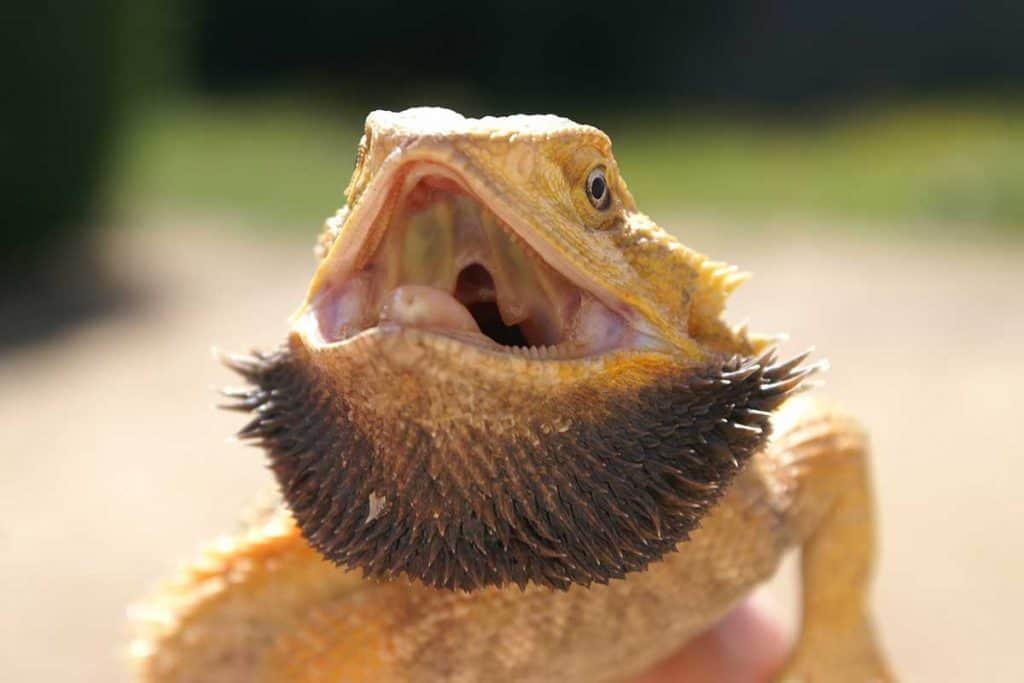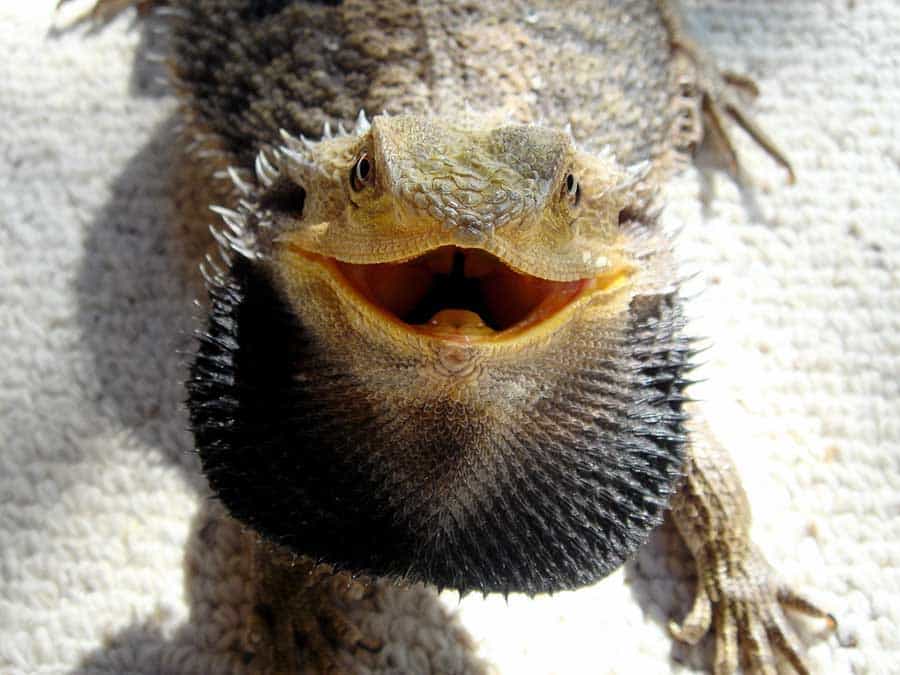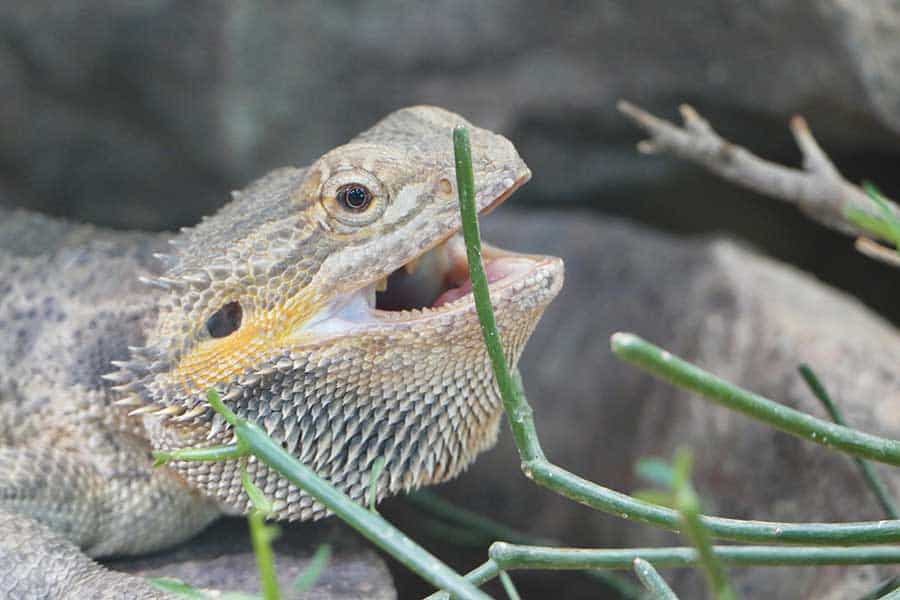Standing with your mouth open means different things for different species. It might signify daydreaming, drooling over something delicious, or even losing your train of thought mid-sentence.
But if you’re a reptile owner, you might have wondered: why do bearded dragons open their mouth? This is called gaping, and usually, beardies do this because it’s too hot for them.
The wider your beardie’s mouth is, the more likely their body is too hot.
That said, you should keep a few other things in mind when trying to figure out why your bearded dragon is holding their mouth open. Keep an eye on where the beardie is sitting when they gape, what they’re doing at the time, and how wide their mouth is open. Context is crucial, because they could just be opening their mouths to eat a fat worm.
The three key clues to look for are:
- Where the bearded dragon is located
- Whether they are standing or sitting
- What else the bearded dragon is doing
Why Is My Bearded Dragon’s Mouth Open?
Just Relaxing
First, how wide is the space between your bearded dragon’s lips? If it’s just a few millimeters, your dragon could just be chilling. This may happen as they lie in their lizard lounger. If they’re awake and resting, a slightly open mouth could just mean they’re relaxed and spaced out.
Similarly, if your bearded dragon has their mouth open while they’re nuzzling your neck, napping on your lap, or scrabbling up your shoulder, it may mean they’re comfortable and at ease in your presence.
Time to Eat
Your beardie could also be following your feeding cues. You may have trained your bearded dragon to feed at certain times. Thus, when you hand-feed them live bugs and wriggly worms, it’s both a bonding ritual and a meal. They know it’s time to hang out and have a snack.
So maybe your bearded dragon has their mouth open because they’re anticipating food as you approach their tank. You also want to look at the position of their tongue. If their mouth is open but their tongue stays inside, it’s probably a response to excess heat within the room.
Exploring
But if your bearded dragon’s mouth is open and their tongue is darting out, they’re just exploring. Lizards and other reptiles use their tongues to ‘sniff’ the air. They might dart their tongues in and out like a snake, or they may sometimes lick something to catch its scent. This is normal.
Cooling Off
If you’re unsure of why your bearded dragon’s mouth is open, point a heat gun at the point they’re standing on or check the
We’ll talk about this in a bit.
Getting Ready to Fight
When your beardie’s open mouth is accompanied by other signs like a puffed-up beard and a tense body, they might be feeling threatened and wants to appear bigger and scarier.
Look around for the source of the threat and try to address it. You’ll learn more about this in a latter section of this article.
When a Beardie Opens Their Mouth to Cool Off
Your Body Heat
Usually, an open mouth is a built-in cooling mechanism.
One of the reasons bearded dragons are such popular pets is their sociability. We’ve talked about these lap lizards cuddling or snuggling with you. When they do that, they draw body heat from you. So if you’re too hot, they soon will be too, and their mouth may start to open.
Especidally when accompanied by heavy breathing, you can compare it to a cat/dog panting, and it’s a fast way of releasing body heat. Remember, lizards are cold-blooded reptiles, which means they have no internal tools to regulate or maintain body temperature as mammals do.
Of course, if your body gets too warm, they’ll scrabble off to a cooler spot. But if they’re still enjoying your company, they may hesitate to leave. A light misting lets them extend their quality time with you, and they may even lick the water droplets off their nose and mouth for a quick drink.
Room Temperature
Your beardie could also get overheated from the ambient room temperature, resulting in them opening their mouths to let off some heat. If it’s a hot time of year, your curtains are open, and the AC is off, the room may get too stuffy and oppressive for your bearded dragon. You may need to open the windows or go outside for fresher, cooler air.
Signs to Look for
Sometimes, you’ll see your beardie sitting in their favorite hotspot with their lips parted and their mouth open.
This doesn’t mean your bearded dragon has lost their voice. It means they’re not ready to leave their basking spot just yet, but they’re feeling a little flushed. So, they open their mouths to let some heat out to regulate their body temperature. It’s a crucial survival tactic for their hot natural habitats (in the Outback).
Because bearded dragons have no sweat glands, their only options when things get too hot are:
- Open their mouth to cool down
- Run to a comfier spot
- Take a bath if there’s water nearby
What You Can Do to Help
A bearded dragon uses the objects within their enclosure to stay warm or cool down. That’s why your
Sometimes the tank may overheat slightly, and if the beardie has nowhere to go, their mouth will stay open.
Ideally, you should place your beardie’s basking light at one of the far sides of the tank. You can invest in artificial reptile caves or use a DIY option like decorated terracotta pots and place them on the cool side of the tank. Your beardie can hide in these when they feel too hot.
However, they also need shaded areas to cool their bodies down.
Now that you understand the reasons why your bearded dragon opens their mouth from time to time, you should give your scale baby a shaded area or two. Set up a cool zone away from the basking area and keep it around 80 to 90 degrees Fahrenheit.
You could also have a mister on hand so you can give your beardie a cool spritz when you’re hanging out with them.
You want to be sure your bearded dragon is always cool and comfortable. But you also don’t want them getting too cold, as that may trigger premature brumation. It’s useful to understand bearded dragon gaping patterns and what (if anything) you need to do about it.
Ordinarily, your beardie will be peacefully basking in their favorite spot. As things start to heat up, they may open their mouths slightly. Their mouths will gradually open wider until they eventually scamper off to a cooler spot.
If they stay in the same spot, though, keep an eye on them. This could mean their bodies are starting to overheat, but they’re unable to move for a different reason…
When Mouth Is Open Because They’re Scared
Maybe they’re frozen in place because they don’t feel safe enough to move. Remember, the basking spot is generally the highest physical position in the
So your bearded dragon might be wary of getting closer to another dragon if they move away from their high spot. Alternatively, they may be confused by noisy activity outside their tank. This could happen if your reptile room has a lot of human traffic, or if the beardie is often disturbed.
Bearded dragons get their name from the sensitive spikes at their throat that give them a bearded appearance. These spikes puff up when beardies are threatened or when they’re displaying mating behavior. Sometimes, your beardie might open their mouth for a few moments as they puff up their beards.
This is called a defensive pose, and it means your beardie is getting ready to fight.
Signs to Look for
If your beardie is outside their basking spot and their mouth is open, watch the rest of their body. If their mouth is open defensively, you may notice these accompanying actions:
- They might open and close their mouth repeatedly.
- They might stand completely still and seem tense.
- Their limbs will be stretched taut and their bodies may be raised.
- They hold their body at an angle with their flattened back facing their foe.
- Their eyes may be focused on an object or animal they see as a threat.
- They might bob their head and stomp their feet with their mouth open.
- They might blacken their beards and hiss at their perceived enemy.
When a bearded dragon gets into a defensive pose, two things can happen. Some more dominant male dragons will intimidate and possibly attack their rival, even if the rival is just a stuffed toy or a Roomba. Submissive female dragons, on the other hand, may simply turn and run away.
If your beardie feels threatened, they’ll part their lips a little and stiffen their legs to stand taller. They might also balloon their bodies by inhaling air to make themselves look larger. But if they’re frightened, they may open their mouth wide to mimic a scream.
They won’t make any sound other than a very quiet hiss, but it can look like they’re shrieking. They might also run off in a panicky, agitated manner and blacken their beard. Relocate your dragon away from the source of their stress. Handle them carefully, since they’re more likely to scratch or bite you in this frightened state.
What You Can Do to Help
Look around your beardie to see what’s getting them worked up. It could be another pet, a rival lizard, or anything unfamiliar. It could even be humans walking in and out of the room.
Once you know what’s upsetting your scale baby, remove the source of stress. You may want to carry your dragon to a quieter, calmer spot, so get down to their level and place your palms under their belly to gently lift them. You want to approach them from below or the side, not above, since looming over them feels combative and can make them more aggressive.
Or you could distract them with a snack. You could even take them for a walk to release that pent-up energy.
If you have more than one bearded dragon sharing a tank, they may startle each other if they suddenly rush for food. Or when one dragon scampers to greet you, the other dragon may feel snuck up on.
Usually, it’s best to keep bearded dragons in separate tanks, as they are mostly solitary animals. However, you could also put visual dividers in their
This makes it harder for your beardies to see each other and accidentally scare one another. Once your beardie has calmed down, they’re likely to close their mouths, and you can soothe them with a treat. If they’re still bobbing their heads or flicking their tails, take them outside for some supervised exercise.
Be careful when handling your bearded dragon when they’re upset. Their claws and teeth are quite sharp, and they may bite or scratch if they feel threatened. So if you need to calm them quickly, very gently lift, move, and comfort them.
FAQs About Bearded Dragon Mouth Opening
You now know why your bearded dragon’s mouth is open, but here are a few more questions you may have about bearded dragon mouth behavior.
Is my bearded dragon yawning?
An open mouth does sometimes indicate a yawn, whether it’s from hunger, exhaustion, or boredom. However, your beardie doesn’t yawn quite as mammals do.
Instead of just opening their mouth wide, your beardie yawns by puffing out their beard without darkening it and opening their mouth slightly. You may notice this early in the morning or when your bearded baby is getting up from a nap. It’s their reflexive way of stretching their throat muscles after that idle period of sleep.
Does my beardie need a toothbrush?
You may be surprised to know bearded dragons can get gum disease and develop unhealthy teeth, especially if you’re feeding them too many sugary fruits. While biting live insects and crunchy vegetables will partially clean your beardie’s teeth, you can help by gently brushing them twice a week. Use a cotton swab dipped in diluted povidone-iodine or chlorhexidine to clean their teeth.
My beardie’s mouth is open. Is he hungry?
You’re most likely to see your beardie sitting open-mouthed on their basking rock. Most of the time, your bearded dragon will sit under their basking spot after meals. It’s a natural habit because, in the wild, a beardie will often eat, poop, bury said poop, then go to a safe hot spot and chill out. The heat helps them digest their food. It’s unlikely your bearded dragon is hungry at that point.
My bearded dragon is smiling. Is she happy?
Sometimes, your bearded dragon will have the front part of their body slightly raised, their back legs lazing and splayed out, and their mouth slightly open. Their eyes will look alert and bright, making it seem like they’re smiling. That probably means your beardie is comfortable, full, and pleased, so yes, they’re happy! Watch their body for cues and pet them if they tolerate it.
My beardie opens his mouth during videos. Is he trying to talk?
Beardies are quite social and outgoing, and pet parents often impose human behaviors onto animals. When you see an open-mouthed look on your beardie’s face, you may assume they’re reacting the way you would. So it makes sense you’d think your scale baby is copying you as you speak into the camera.
However, it’s far more likely the heat from your video lights is causing your beardie to overheat slightly. They could also be responding to your bedroom lights, since these often emit heat as well. Yellow lights and tungsten lights are the warmest, so consider getting colder lights if this happens often while you’re handling and recording your beardie.
Why is my bearded dragon drooling?
If your bearded dragon has stringy saliva dripping out of their mouth, it probably means they’re dehydrated. Be sure to provide them with a fresh, clean water source at all times.
It also helps to mist your beardie once or twice a day and allow them to lick the water droplets off their mouth. You can also bathe your dragon in warm water to keep them hydrated.
But remember, if the
How do I help my bearded dragon cool down?
Your instinctive response may be to give your bearded dragon a cool bath. While that works, it may not always be helpful.
For example, if your beardie is basking, their body is usually busy digesting food. If you immediately take them away from their basking spot, it could mess with their digestive system and make them constipated later.
Instead, lightly mist your beardie’s head while letting them finish off their siesta. But not too much mist – you don’t want the tank getting too humid.
So, Why Does My Bearded Dragon Open His Mouth?
Usually, the reason why bearded dragons open their mouth is that they are too hot but not quite ready to leave their basking spot just yet. When the heat overwhelms your bearded dragon, they’ll move to the cooler side of the tank or exhibit “glass surfing” behavior to cool down. You could also try giving them a bath to cool them off.
However, if they stay under their




